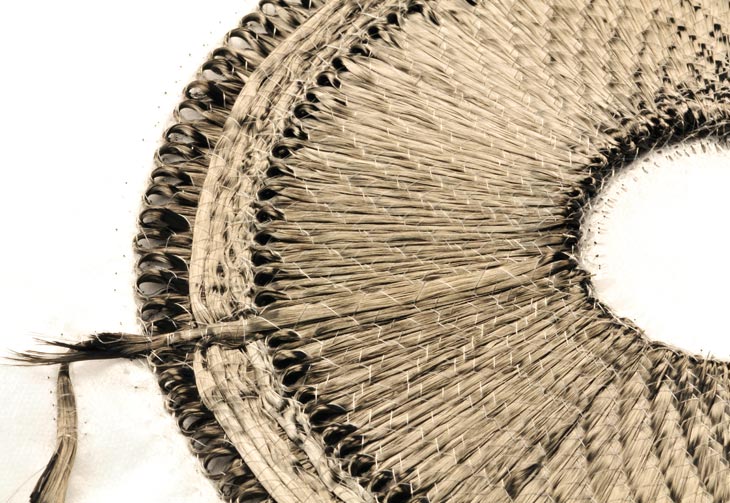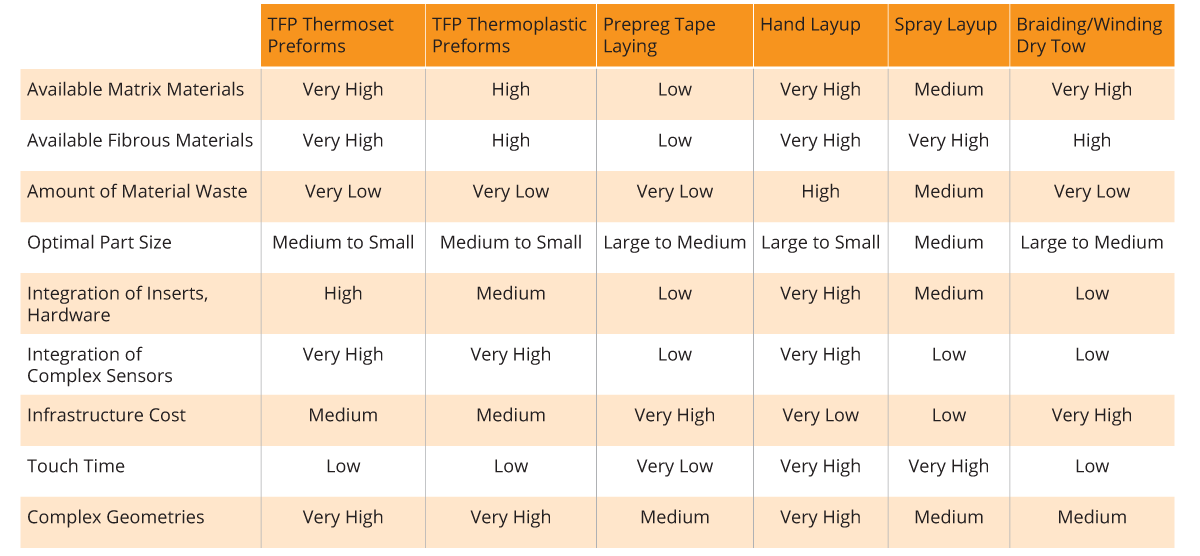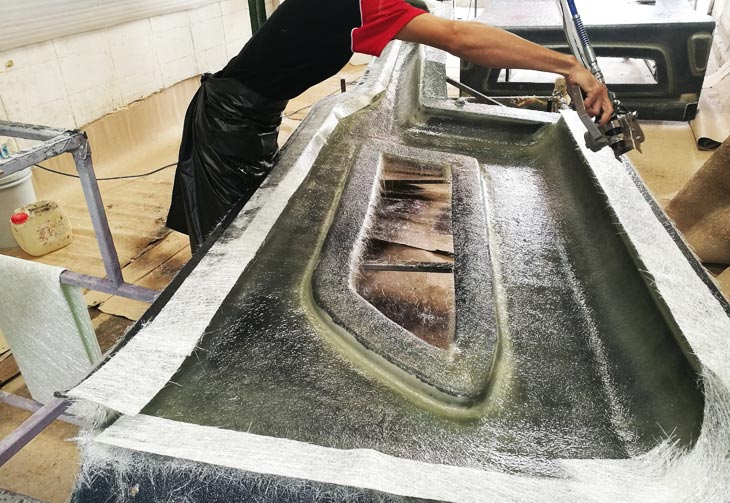Composite processes:
When to consider Tailored Fiber Placement?
Tailored fiber placement, or TFP, serves a unique role in the composites manufacturing process. While it does not fit every application, TFP is a versatile process that can be used for many applications.
This article attempts to review and compare a few of the most used composites processes such as tape laying, hand layup, braiding, and filament winding to TFP and examines the advantages and disadvantages of the technology for those selected processes. The outcomes drawn are for general cases and may not fit every application. Talk to a TFP composites expert for further recommendations and evaluations for your specific test case.
Tape laying
Tape laying is a competing technology to TFP for composite production with its own set of advantages and disadvantages. Tape laying uses a robotic head to place thin tapes usually of resin impregnated composite material onto a mold. An infrared heater on the head secures the tape to the mold and cures the epoxy in a rapid process. This technique works incredibly well for large shell-like shapes.
Large aerospace shells for fighter jets, boat shells, and even bathtubs have historically been created with tape laying. Since tape laying creates a very thin oriented fiber structure, there can be mechanical advantages if the composite is properly designed and the loading scheme simple.
However, tape laying is not generally as effective as TFP when it comes to medium sized parts with a surface area smaller than a surfboard and larger than a postage envelope. Additionally, as tapes are laid flat against the mold, they do not have the same amount of mechanical tailor-ability specifically regarding curved structures, variable heights, or circular hole reinforcement.
TFP allows the composites engineer to create curvilinear paths to best resist the complex applied mechanical loading. While these tailored models are generally more complex to calculate than classical laminate theory, they can reduce the amount of composite materials used to create the composite preform.

Dry carbon fiber preform created by TFP allows for control of radial and curvilinear reinforcement.
Tape laying machines are also considerably more expensive to purchase and setup than TFP machines. Additionally, tape laying machines generally create a single part per machine at a time while TFP can create many copies of the same part at once increasing scalability. Finally, TFP allows for the inclusion of wires and other sensors into the composite turning the composite fabric itself into a Smart Textile. TFP preforms can also be made in advance and shipped to another location potentially allowing more supply chain flexibility.
In short: Both TFP and tape laying are highly automated technologies. Consider tape laying if you have very large parts such as boat shells that have simplified loading structures. Consider TFP if you have medium sized parts with complicated loading, internal curvilinear structures, or want to add sensors directly to the composite.

Fig. 02: A brief analysis and comparison of TFP to alternative composites techniques
Hand layup of wovens
Hand layup using cut woven laminates is one of the most widely used techniques to create a wide variety of composites.
In this process, carbon fibers are woven in to a fabric, which is then cut to fit a specific mold. Sheets of fabric are oriented to help resist and distribute loading across the form. These sheets are layered into the mold by hand and then set into place with a matrix material.
Hand layup of wovens requires minimal equipment investment making it attractive for early prototypes or one-off products.

Fig. 01: A worker completes a composite layup for a small sized complex geometry. While the infrastructure cost is initially less, success for this technique is dependent on the skill of the labor. .
However, the process of hand layup using wovens is highly labor intensive and the quality depends on the skill of that labor. TFP can reduce some of the touch time by creating a preform that is handled more easily and does not lose internal fiber orientations when put into the mold as all orientations are stitched into the preform itself.
The process of weaving these carbon fibers into a workable fabric additionally adds cost to the material making hand lay up with the wovens more expensive than the individual cones of carbon fiber tow used in TFP.
Significant waste material of this expensive woven composite material is generated in the cutting process which further reduces material efficiency. TFP utilizes carbon fiber tow directly from the cone which is cheaper than woven fabrics as it has not gone through the additional weaving process. Controlling the placement of a carbon fiber tow in the preform with TFP can also result in significantly increased mechanical advantages at further decreased material usage.
In short: consider hand layup of woven materials if you have access to skilled labor and are going to produce one-off products or replacements. Consider TFP if you’re going to make more than a few pieces, need higher mechanical properties and accuracy, or want to reduce the amount of waste and corresponding cost of expensive woven fabrics.
Spray layup
Spray layup is a sister technique to hand layup of laminates. In spray layup, short fibers are mixed with a low viscosity resin in a mixing tank, and then sprayed directly into a mold where they cure. This process is low cost as it relies on minimal equipment, has limited waste, and requires limited skilled labor. However, this process has multiple disadvantages when compared with other techniques. As short fibers are used, the mechanical properties of the resulting composite are not as desirable as other techniques with long fibers.
Additionally, composites made with spray layup tend to be heavy due to their increased use of resin to help propel the fibers into the spray. This further compromises mechanical properties leading to a less engineered composite. Available resins are more limited due to viscosity requirements, potentially removing materials from the available selection. Additionally, there can be health and environmental impacts of the vaporized droplets of resin that could potentially cause added long-term costs.

Fig. 03: A worker sprays chopped fiberglass into the resin stream for fast composite construction. However, the resulting mechanical properties are less controlled and optimized when compared with TFP on medium to small geometry parts.
Additionally, composites made with spray layup tend to be heavy due to their increased use of resin to help propel the fibers into the spray. This further compromises mechanical properties leading to a less engineered composite. Available resins are more limited due to viscosity requirements, potentially removing materials from the available selection. Additionally, there can be health and environmental impacts of the vaporized droplets of resin that could potentially cause added long-term costs.
In short: the benefits of TFP to spray layup are application specific. If the part is a medium or small sized part that requires reduced mass, TFP might be considered especially for high cost materials or unique resins. However, the vast majority of large parts that utilize spray lay-up and do not require further mechanical optimization, will not be good candidates for TFP.
Braiding and filament winding
Braiding and filament winding are two separate techniques that can occasionally compete with TFP. Both processes can be considered covering or wrapping processes in which a mandrel is covered with the composite materials. In general, these techniques are extremely cost effective and work best for long, tubular shapes, or pressure vessels. Both processes are extremely cost efficient, quick, and provide good mechanical properties to the composite. However, the shape of the mandrel significantly limits the type of composite products that can be made this way. Additionally, surface finish is more difficult to control unless exterior molding is used.
TFP competes with this technology only for medium to small size bar reinforcement. In these applications, the TFP preform is wrapped around the mandrel and set. This can provide adequate flexural stiffness, however does not provide good burst strength. Therefor, it should not be used for storage vessels. Additionally, parts for TFP based wrapping will generally be sufficiently smaller than that in filament winding.
In short: If you have medium to small sized reinforcement bracket, designing it for TFP manufacture could possibly provide some scalability benefits. Using TFP as a replacement for braiding or filament winding for vessels that store pressure is not recommended.
Summary
Tailored fiber placement can provide interesting benefits and cost reduction in the manufacture of composite products. The benefits are further maximized when introduced early in the composites design process. Additional new technologies such as sensors and inserts can be utilized easily in TFP. The wide range of available materials that can run in TFP, including carbon, glass, natural, and biomedical fibers, further increases design possibilities.
However, TFP does not always provide the best composites solution especially for larger parts. Consult a TFP expert at ZSK STICKMASCHINEN to inquire if your part is compatible.

